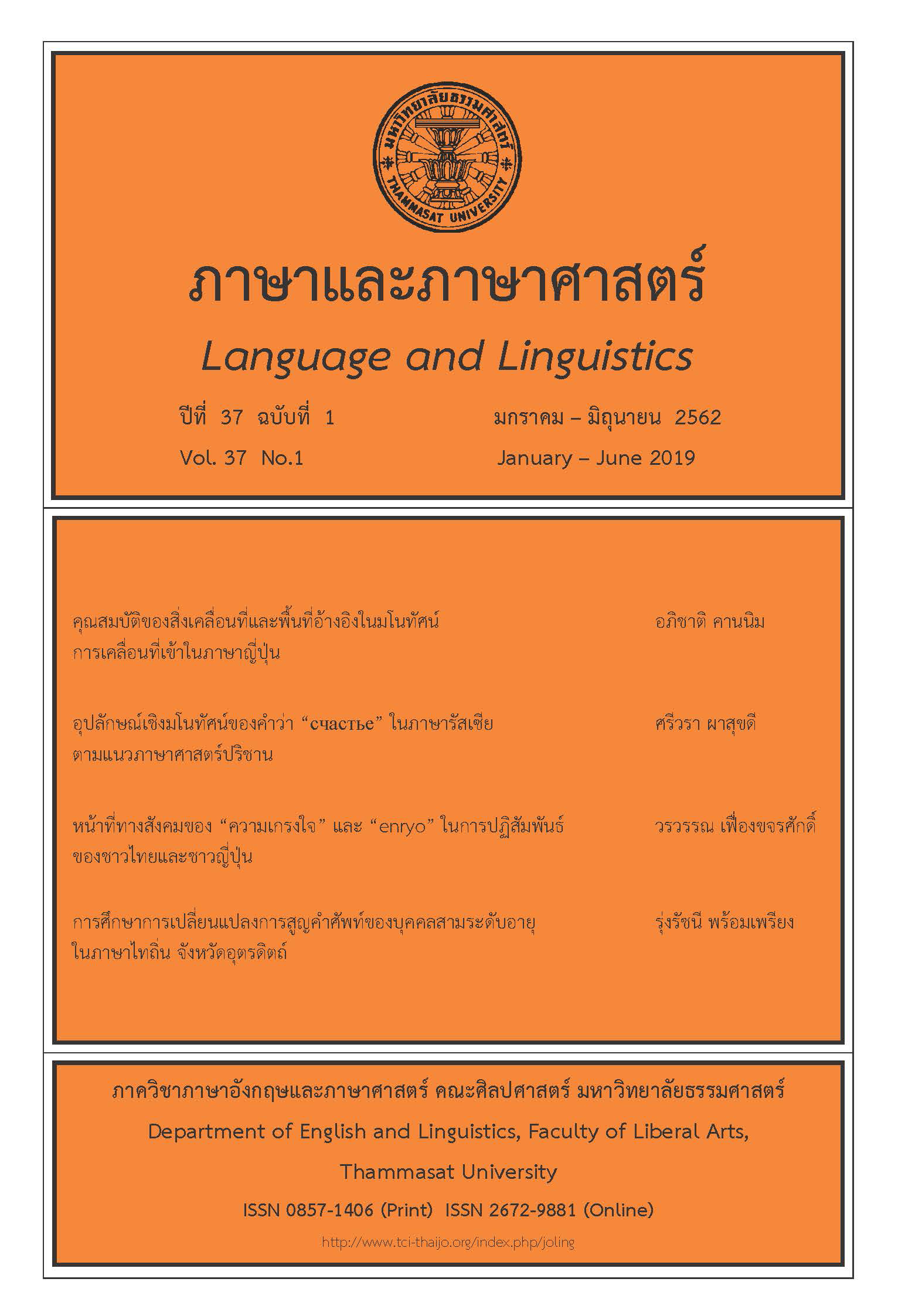The Characteristics of Figures and Grounds in Japanese Entering Concepts
Main Article Content
Abstract
This study aims to analyze the characteristics of Figures and Grounds in conceptualization of entering in Japanese language according to cognitive linguistics. The study method included collecting verbs expressing the entering from Ruigojiten Dictionary, and collecting sentences from Japanese Corpus to analyze the characteristics of those Figures and Grounds which appeared in the events of entering. The findings were that the Figures comprised of three characteristics: (1) volition of entering, (2) independence, and (3) self-controllability. If entities in the events have all of these characteristics, they will be considered as good Figures. However, if the entities have only some of these characteristics, there will be tendency to function as Grounds in those events. In addition, there are some more factors such as size - the Figures should be smaller than the Grounds, and the verbs which appeared together with Figures and Grounds. In terms of the characteristics of the Grounds in conceptualization of entering, the results showed that the prototype of Grounds are hollow, having clear boundary, with enclosure in which the Figures can move inside. Moreover, the Grounds can be categorized into three types: (1) three-dimension Grounds which are hollow inside, with an entering cavity, (2) three-dimension Grounds which are not hollow, and without entering cavity, (3) two-dimension Grounds which are flat.
Article Details
บทความทุกบทความเป็นลิขสิทธิ์ของภาษาและภาษาศาสตร์
References
จุฬาลงกรณ์มหาวิทยาลัย, กรุงเทพฯ.
. (2561). อรรถศาสตร์. กรุงเทพฯ: จรัลสนิทวงศ์การพิมพ์.
Chu, C. (2004). Event conceptualization and grammatical realization: The case of motion in Mandarin Chinese (Doctoral dissertation). University of Hawaii at Manoa, Honolulu.
Gendai nihongo kakikotoba kinkoo koopasu. (2015, December 11). Retrieved from https://www.kotonoha.gr.jp/shonagon/
Greenberg, J. H. (1963). Some universals of grammar with particular reference to the order of meaningful elements. In J. H. Greenberg (Ed.), Universals of language (pp. 58–90). Cambridge, MA: MIT Press.
Ibarretxe-Antuñano, I. (2003). Entering in Spanish: conceptual and semantic properties of entrar en/a. Annual Review of Cognitive Linguistics, 1, 29-58.
Johnson, M. (1987). The body in the mind: the bodily basis of meaning, imagination, and reason. Chicago, IL: University of Chicago Press.
Kita, S. (1999). Japanese enter/exit verbs without motion semantics. Studies in Language, 23(2). 307-330.
Lin, J. (2013). A figure’s final location must be identifiable: Localizer distribution in Chinese motion expressions. Proceedings of the 37th Annual Meeting of the Berkeley Linguistics Society, USA, 37, 242-256. Retrieved from https://escholarship.org/uc/item/7107f3ws
Miller, G. A., & Johnson-Laird, P. N. (1976). Language and perception. Cambridge, MA: The Belknap Press of Harvard University Press.
Senft, G. (1999). Enter and exit in Kilivila. Studies in Language, 23(1). 1-23.
Shibatani, M. (1990). The language of Japan. Cambridge, England: Cambridge University Press.
Shibata, T., & Yamada, S. (2002). Ruigo Daijiten (類語大辞典). Tokyo, Japan: Kodansha.
Talmy, L. (2000a). Toward a cognitive semantics volume I: Concept structuring systems. Cambridge, MA: MIT Press.
________. (2000b). Toward a cognitive semantics volume II: typology and process in concept structuring. Cambridge, MA: MIT Press.


